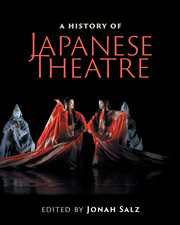Book contents
- Frontmatter
- Contents
- List of figures
- List of tables
- Contributors
- Contributors’ biographies
- Foreword
- Acknowledgments
- Note on Japanese terms
- List of abbreviations
- Timeline
- Editor's introduction
- I Traditional theatres
- Preface to Part I Japanese civilization arises
- II Modern theatres
- Preface to Part II
- III Arcs and patterns
- 12 Premodern playwriting practices
- 13 Traditional meta-patterns
- 14 Modern plays as literature
- 15 Modern meta-patterns
- Interlude Dōjōji: The lady and the bell
- IV Theatre architecture
- Preface to Part IV Evolution of Japanese theatre architecture
- V Theatre criticism
- VI Intercultural influences
- Epilogue: Frozen words and mythology
- Further reading
- Index
14 - Modern plays as literature
from III - Arcs and patterns
Published online by Cambridge University Press: 05 July 2016
- Frontmatter
- Contents
- List of figures
- List of tables
- Contributors
- Contributors’ biographies
- Foreword
- Acknowledgments
- Note on Japanese terms
- List of abbreviations
- Timeline
- Editor's introduction
- I Traditional theatres
- Preface to Part I Japanese civilization arises
- II Modern theatres
- Preface to Part II
- III Arcs and patterns
- 12 Premodern playwriting practices
- 13 Traditional meta-patterns
- 14 Modern plays as literature
- 15 Modern meta-patterns
- Interlude Dōjōji: The lady and the bell
- IV Theatre architecture
- Preface to Part IV Evolution of Japanese theatre architecture
- V Theatre criticism
- VI Intercultural influences
- Epilogue: Frozen words and mythology
- Further reading
- Index
Summary
During the rise and ascendancy of shingeki, “new theatre,” dramas created by several generations of Japanese playwrights came closest to models of Western theatre. From roughly 1910 to 1970, the playwright became central, and stage speech the most powerful tool available to the dramatist. Both prior traditional and later avant-garde Japanese theatre show far less commitment to the ascendancy of words or emphasis on (relatively) realistic dialogue. The Japanese plays of this “classic shingeki” period are thus much closer to our received ideas of theatre than those created during any other period before or since.
Cultural framework
Nevertheless, there are dangers in trying to understand and interpret these plays too quickly in terms of any purely Western model. A rich and nuanced reading of these play texts first requires a sociopolitical framework to help situate the plays in their cultural matrix. In terms of the development of shingeki, at least two fresh opportunities borrowed from Europe allowed dramatists to attempt extraordinary innovations: to write convincing, realistic spoken dialogue; and, an imperative felt particularly in left-wing circles, to introduce politics as subject matter – a topic virtually impossible to imagine in earlier theatrical periods.
One issue might be defined as the question of national patrimony. For most of this period, playwrights tended to reject the abstraction and overt theatricality of traditional theatre forms – noh, bunraku, and kabuki. During the period of shingeki's development, the strong preference for Western models persisted, notably Ibsen, Chekhov, and later Brecht, while Shakespeare remained a central locus of reference. During this period, only Izumi Kyōka (1873–1939), whose plays were generally first produced by somewhat more traditional shimpa troupes, and Mishima Yukio (1925–70) consistently made use of traditional Japanese theatre's aesthetic strategies.
The most highly respected literary figures of these years – Natsume Sōseki and Shiga Naoya – never wrote for the theatre. Others such as Tanizaki Jun'ichirō and Shimazaki Tōson made a few brief and youthful attempts at composing for the theatre, yet their plays never became central. In terms of national (and international) stature, Japan produced no culturally dominating theatrical figures, popular among intellectuals as well as the public, such as George Bernard Shaw, Jean-Paul Sartre, Arthur Miller, or Tennessee Williams.
- Type
- Chapter
- Information
- A History of Japanese Theatre , pp. 386 - 396Publisher: Cambridge University PressPrint publication year: 2016
- 1
- Cited by

